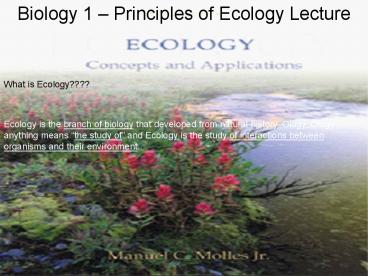Biology 1 Principles of Ecology Lecture - PowerPoint PPT Presentation
1 / 14
Title:
Biology 1 Principles of Ecology Lecture
Description:
Ology, Ology anything means 'the study of' and Ecology is the study of ... While abiotic factors are 'nonliving,' they are still studied by scientists ... – PowerPoint PPT presentation
Number of Views:829
Avg rating:3.0/5.0
Title: Biology 1 Principles of Ecology Lecture
1
Biology 1 Principles of Ecology Lecture
What is Ecology????
Ecology is the branch of biology that developed
from natural history. Ology, Ology anything means
the study of and Ecology is the study of
interactions between organisms and their
environment.
2
The Biosphere -
The portion of Earth that supports living things
1. Air
2. Land
- Water
- a. fresh
- b. salt
3
The nonliving environment Abiotic factors While
abiotic factors are nonliving, they are still
studied by scientists because they are part of a
living organisms environment. Examples 1. air
currents
2. temperature
3. moisture
4. light
5. soil
4
- The living environment Biotic factors
- All the living organisms that inhabit an
environment are called biotic factors. - Examples in a pond
- fish
2. plants
3. frogs
4. mosquito larvae
5. water strider
5
Levels of Organization
In order for Ecologists to study an environment
completely, it is beneficial to break up entire
scheme of organization down into distinct levels
1. individuals
2. populations
3. communities
4. ecosystems
6
1. individuals
7
2. populations a group of organisms, all of the
same species, which interbreed and live in the
same area at the same time
8
3. communities a biological community is made up
of interacting populations in a certain area at a
certain time.
9
4. ecosystems are made up of interacting
populations in a biological community and the
communitys abiotic factors.
10
Organisms in Ecosystems
1. Habitat is the place where an organism
lives out its life.
- Niche is all the strategies and adaptations a
species uses in its environment
a.) how it meets its specific needs for
food and shelter
b.) how and where it survives
c.) where it reproduces
11
Survival Relationships Studies have shown that
most species survive because of the relationship
they have with other species. The relationship
in which there is a close and permanent
association between organisms of different
species is called symbiosis.
12
Three kinds of symbiosis are recognized
mutualism, commensalism, parasitism
1. Mutualism a symbiotic relationship in which
both species benefit.
13
2. Commensalism is a symbiotic relationship in
which one species benefits and the other species
is neither harmed nor benefited.
14
3. Parasitism a symbiotic relationship in
which a member of one species derives benefit at
the expense of the other species(the host).































